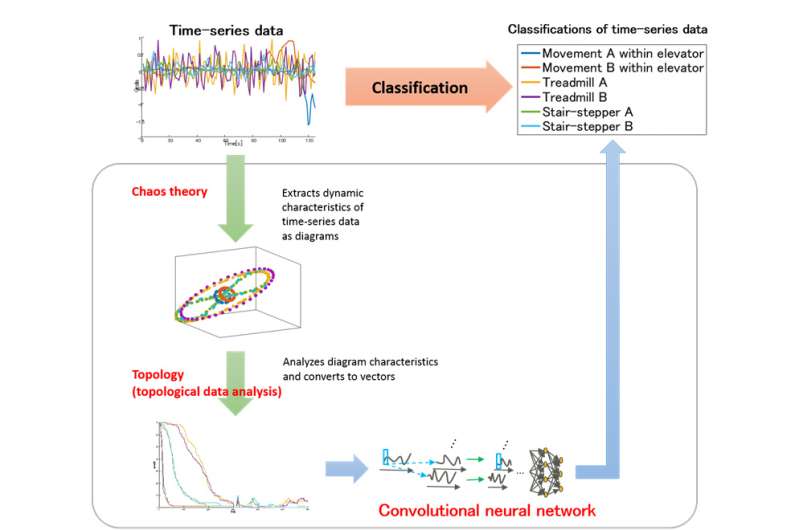Fujitsu develops new deep learning technology to analyze time-series data with high precision

Fujitsu Laboratories today announced that it has developed deep learning technology that can analyze time-series data with a high degree of accuracy. Demonstrating promise for Internet-of-Things applications, time-series data can also be subject to severe volatility, making it difficult for people to discern patterns in the data. Deep learning technology, which is attracting attention as a breakthrough in the advance of artificial intelligence, has achieved extremely high recognition accuracy with images and speech, but the types of data to which it can be applied is still limited. In particular, it has been difficult to accurately and automatically classify volatile time-series data–such as that taken from IoT devices–of which people have difficulty discerning patterns.
Now Fujitsu Laboratories has developed an approach to deep learning that uses advanced mathematical techniques to extract geometric features from time-series data, enabling highly accurate classification of volatile time-series. In benchmark tests held at UC Irvine Machine Learning Repository that classified time-series data captured from gyroscopes in wearable devices, the new technology was found to achieve roughly 85% accuracy, about a 25% improvement over existing technology. This technology will be used in Fujitsu's Human Centric AI Zinrai artificial intelligence technology. Details of this technology will be presented at the Fujitsu North America Technology Forum (NAFT 2016), which will be held on Tuesday, February 16, in Santa Clara, California.
Background
In recent years, in the field of machine learning, which is a central technology in artificial intelligence, deep learning technology has been attracting attention as a way to automatically extract feature values needed to interpret and assess phenomena without rules being taught manually. Especially in the IoT era, massive volumes of time-series data are being accumulated from devices. By applying deep learning to this data and classifying it with a high degree of accuracy, further analyses can be performed, holding the prospect that it will lead to the creation of new value and the opening of new business areas.
Issues
Deep learning is a potent machine learning technique, and it is attracting attention as a breakthrough in the progress of artificial intelligence, but so far it has only been able to be effectively applied to limited types of data, such as images and speech. In particular, for complex time-series data that is subject to severe oscillations and captured by sensors embedded in IoT devices, it has so far been difficult to achieve highly accurate classifications using deep learning or any other machine learning techniques.
About the Technology
Now Fujitsu Laboratories has developed deep learning technology that uses advanced chaos theory and topology to automatically and accurately classify volatile time-series data. This can accurately handle even complex time-series data with severe oscillations. The technology uses the following procedures to learn and classify:
1. Graphically represents time-series data using chaos theory
Numerical data captured by sensors are represented superficially as the product of a complex combination of dynamic movements. While it is difficult to directly investigate the mechanisms of these dynamic movements, plotting changes over time on a graph is known to reveal characteristic tracks for each mechanism of movement. Applying this graphic approach makes it possible to distinguish between the time-series data via diagrams.
2. Quantify the diagrams using topology
Because it is difficult to directly apply machine learning to the diagrams created in step 1, Fujitsu Laboratories applied topological data analysis(3) to express features of the diagrams as numbers. With this method, rather than the features one might normally associate with a graphical image, the number of holes contained in the diagram and the major shape features are analyzed and then converted into a propriety vector representation.
3. Learning and classification using a convolutional neural network
Fujitsu Laboratories newly designed a convolutional neural network that trains on the propriety vector representations from step 2, enabling the classification of volatile time-series data.
Results
Using the time-series data from gyroscopic sensors built into wearable devices, this technology was found to achieve an accuracy of approximately 85%, an improvement of about 25% over existing techniques, on the UC Irvine Machine Learning Repository benchmark test for classifying human activities. In tests to infer mental states using brainwave time-series data, this technique achieved an accuracy of about 77%, a roughly 20% improvement over existing techniques. This technology extends the types of data to which deep learning can be applied to time-series data. Moreover, because it can very accurately classify time-series data with severe oscillations, which people have difficulty discerning, it enables new types of analyses. For example, using IoT devices, it could be used to accurately detect equipment anomalies or forecast breakdowns in factories, or could be used to analyze vital-signs data to assist with medical diagnoses and treatment. In ways such as these, it is expected that this technology will bring advancements to a variety of fields through artificial intelligence.
Fujitsu Laboratories will work on further improving the accuracy of its time-series data classification technology with the aim of a practical implementation of it in fiscal 2016 as a core part of Human Centric AI Zinrai. The company is also working to broaden the application of deep learning to types of data other than images, sounds, and time series, and to perform more sophisticated data analysis.
Provided by Fujitsu




















